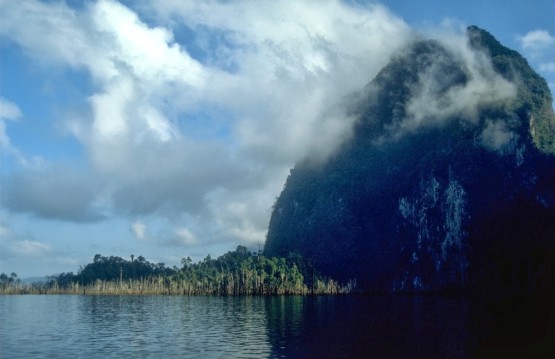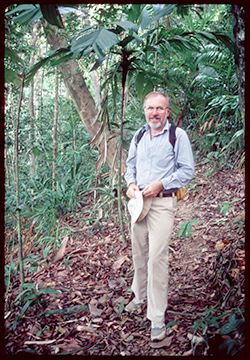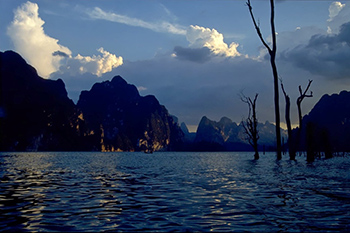Wildlife Extinction Rates Skyrocket After Forest Disturbance
September 26, 2013
By Kim McDonald

Forest islands, such as this one in the Chiew Larn Reservoir in Thailand, were studied by the researchers to examine the ecological impacts of fragmentation.
Photos by Antony Lynam
Species living in rain forest fragments could be far more likely to disappear than previously assumed, according to an international team of scientists that included biologists at the University of California, San Diego.
In a study spanning two decades, published in this week's issue of the journal Science, the researchers witnessed the near-complete extinction of native small mammals on forest islands created by a large hydroelectric dam in Thailand. No one expected the collapse of these protected forest communities to be so rapid.
"It was like ecological Armageddon," said lead author Luke Gibson, a former UC San Diego graduate student now completing his doctorate at the National University of Singapore. "Nobody imagined we'd see such catastrophic local extinctions."
"Tropical forests have long fascinated biologists as treasure troves of species richness and for their rapid year-round pace of ecological and evolutionary activity," said David Woodruff, a professor of biology at UC San Diego who instigated the study. "Conservation biologists have long thought they might have 50 to 100 years to intervene on behalf of threatened animals in the world's remaining forests. But our study shows that local extinctions can occur at two to three times the expected rate."

David Woodruff, a professor of biology at UC San Diego, initiated the studies in 1990.
The scientists found that all 12 native species of small mammals were lost from small patches of rainforest within 25 years of their isolation, when the construction of a hydroelectric dam flooded a national park, leaving dozens of forested hilltops as isolated islands in a lake. Woodruff initiated studies of the islands in 1990, soon after they were created. He began monitoring the mammal populations surviving on each island with three former graduate students and a team of international collaborators.
Initially, the native rats, mice and tree shrews seemed unaffected by their changed circumstances, but 25 years later all have disappeared. Their rapid local extinction is attributed to reduced habitat area and to the arrival of an aggressive rat typically associated with villages and agricultural fields.
The researchers saw native small mammals vanish with alarming speed, with just a handful remaining–on average, less than one individual per island–after 25 years. "There seemed to be two culprits," said William Laurance of James Cook University in Australia, another co-author of the paper. "Native mammals suffered the harmful effects of population isolation, and they also had to deal with a devastating invader – the Malayan field rat."
"This tells us that the double whammy of habitat fragmentation and invading species can be fatal for native wildlife," said Tony Lynam, another co-author who conducted the initial surveys as a doctoral student at UC San Diego, and is now with the Wildlife Conservation Society. "And that's frightening because invaders are increasing in disturbed and fragmented habitats around the world."

The reservoir is surrounded by a wildlife sanctuary and national park, which together make up the largest block of rainforest habitat in southern Thailand.
"The bottom line is that we must conserve large, intact habitats for nature," said Gibson. "That's the only way we can ensure biodiversity will survive."
"To save wildlife and the ecological services it provides in a post-natural world, we need to protect and manage the largest possible areas," added Woodruff. "Our results show that small isolated populations collapse rapidly for ecological and genetic reasons and that smaller protected areas won't save nature. But a mass extinction is avoidable if we learn from these lessons."
Funds to support the study were provided by the U.S. National Science Foundation and the National University of Singapore.
